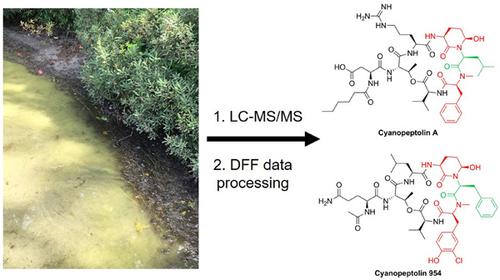当前位置:
X-MOL 学术
›
Environ. Toxicol. Chem.
›
论文详情
Our official English website, www.x-mol.net, welcomes your
feedback! (Note: you will need to create a separate account there.)
Diagnostic Fragmentation Filtering for Cyanopeptolin Detection
Environmental Toxicology and Chemistry ( IF 3.6 ) Pub Date : 2020-11-25 , DOI: 10.1002/etc.4941 Kimberlynn McDonald 1 , Justin B Renaud 2 , Frances R Pick 3 , J David Miller 1 , Mark W Sumarah 2 , David R McMullin 1
Environmental Toxicology and Chemistry ( IF 3.6 ) Pub Date : 2020-11-25 , DOI: 10.1002/etc.4941 Kimberlynn McDonald 1 , Justin B Renaud 2 , Frances R Pick 3 , J David Miller 1 , Mark W Sumarah 2 , David R McMullin 1
Affiliation

|
Cyanobacteria are ubiquitous photosynthetic prokaryotes that produce structurally diverse bioactive metabolites. Although microcystins are extensively studied, other cyanopeptides produced by common bloom‐forming species have received little attention. Cyanopeptolins are a large cyanopeptide group that contain a characteristic 3‐amino‐6‐hydroxy‐2‐piperidone (Ahp) moiety. In the present study we used diagnostic fragmentation filtering (DFF), a semitargeted liquid chromatography‐tandem mass spectrometry (MS/MS) product ion filtering approach, to investigate cyanopeptolin diversity from 5 Microcystis strains and 4 bloom samples collected from lakes in Ontario and Quebec, Canada. Data processing by DFF was used to search MS/MS data sets for pairs of diagnostic product ions corresponding to cyanopeptolin partial sequences. For example, diagnostic product ions at m/z 150.0912 and 215.1183 identified cyanopeptolins with the NMe‐Tyr–Phe–Ahp partial sequence. Forty‐eight different cyanopeptolins, including 35 new variants, were detected from studied strains and bloom samples. Different cyanopeptolin profiles were identified from each sample. We detected a new compound, cyanopeptolin 1143, from a bloom and elucidated its planar structure from subsequent targeted MS/MS experiments. Diagnostic fragmentation filtering is a rapid, easy‐to‐perform postacquisition metabolomics strategy for inferring structural features and prioritizing new compounds for further study and dereplication. More work on cyanopeptolin occurrence and toxicity is needed because their concentrations in freshwater lakes after blooms can be similar to those of microcystins. Environ Toxicol Chem 2021;40:1087–1097. © 2020 SETAC
中文翻译:

用于 Cyopeptolin 检测的诊断碎片过滤
蓝细菌是无处不在的光合作用原核生物,可产生结构多样的生物活性代谢物。尽管对微囊藻毒素进行了广泛研究,但由常见的水华形成物种产生的其他氰肽却很少受到关注。氰肽素是一个大的氰肽基团,含有特征性的 3-氨基-6-羟基-2-哌啶酮 (Ahp) 部分。在本研究中,我们使用诊断碎片过滤 (DFF),一种半靶向液相色谱 - 串联质谱 (MS/MS) 产物离子过滤方法,研究 5 种微囊藻的蓝肽素多样性。从加拿大安大略省和魁北克省的湖泊中采集的菌株和 4 个水华样本。DFF 的数据处理用于搜索 MS/MS 数据集以查找对应于 cyanopeptolin 部分序列的诊断产物离子对。例如,m/z 150.0912 和 215.1183 的诊断产物离子鉴定出具有 N Me-Tyr-Phe-Ahp 部分序列。从研究的菌株和开花样品中检测到 48 种不同的 cyanopeptolins,包括 35 种新变体。从每个样品中鉴定出不同的氰肽素谱。我们从花朵中检测到一种新化合物 cyanopeptolin 1143,并从随后的靶向 MS/MS 实验中阐明了其平面结构。诊断碎片过滤是一种快速、易于执行的采集后代谢组学策略,用于推断结构特征和优先考虑新化合物以进行进一步研究和去复制。需要对蓝藻毒素的发生和毒性进行更多的研究,因为它们在开花后淡水湖中的浓度可能与微囊藻毒素的浓度相似。环境毒物化学2021;40:1087–1097。© 2020 SETAC
更新日期:2020-11-25
中文翻译:

用于 Cyopeptolin 检测的诊断碎片过滤
蓝细菌是无处不在的光合作用原核生物,可产生结构多样的生物活性代谢物。尽管对微囊藻毒素进行了广泛研究,但由常见的水华形成物种产生的其他氰肽却很少受到关注。氰肽素是一个大的氰肽基团,含有特征性的 3-氨基-6-羟基-2-哌啶酮 (Ahp) 部分。在本研究中,我们使用诊断碎片过滤 (DFF),一种半靶向液相色谱 - 串联质谱 (MS/MS) 产物离子过滤方法,研究 5 种微囊藻的蓝肽素多样性。从加拿大安大略省和魁北克省的湖泊中采集的菌株和 4 个水华样本。DFF 的数据处理用于搜索 MS/MS 数据集以查找对应于 cyanopeptolin 部分序列的诊断产物离子对。例如,m/z 150.0912 和 215.1183 的诊断产物离子鉴定出具有 N Me-Tyr-Phe-Ahp 部分序列。从研究的菌株和开花样品中检测到 48 种不同的 cyanopeptolins,包括 35 种新变体。从每个样品中鉴定出不同的氰肽素谱。我们从花朵中检测到一种新化合物 cyanopeptolin 1143,并从随后的靶向 MS/MS 实验中阐明了其平面结构。诊断碎片过滤是一种快速、易于执行的采集后代谢组学策略,用于推断结构特征和优先考虑新化合物以进行进一步研究和去复制。需要对蓝藻毒素的发生和毒性进行更多的研究,因为它们在开花后淡水湖中的浓度可能与微囊藻毒素的浓度相似。环境毒物化学2021;40:1087–1097。© 2020 SETAC











































 京公网安备 11010802027423号
京公网安备 11010802027423号